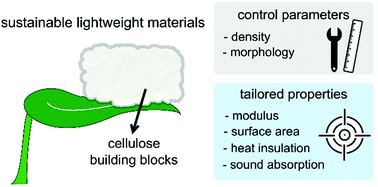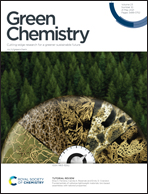Fundamentals of cellulose lightweight materials: bio-based assemblies with tailored properties
Abstract
This review focuses on lightweight materials (foams, aerogels, cryogels, xerogels) obtained from lignocellulosic fibres, nanocelluloses, and regenerated celluloses, in which the dried assemblies are achieved through ambient/oven-drying, freeze-drying, or supercritical drying. The fundamental properties that characterize these materials include apparent density (ρapp), mechanical strength, specific surface area, and capacity for heat insulation and sound absorption. While similar properties can be obtained from any of the cellulose building blocks by simply adjusting ρapp and the solid architecture, the highest specific surface areas (ca. 600 m2 g−1) can only be achieved with nano or regenerated celluloses. We elucidate processing–structure–property relationships to support the design of sustainable materials prepared through cost-effective and green processes that save unnecessary steps, chemicals, and solvents. Efficient methods to tailor lightweight material properties are described, including three approaches to lower ρapp, four routes to increase specific surface area, and three strategies to enhance compressive modulus. For added functionality in the structures, renewable compounds that, for example, cross-link, hydrophobize, and protect from microbial activity are presented. The tunability of these green materials enables a large range of applications such as protective packaging, construction, sorbents, biomedical devices, environmental remediation, automotive, electronics and apparel.

- This article is part of the themed collections: 2021 Green Chemistry Hot Articles and Green Chemistry Reviews


 Please wait while we load your content...
Please wait while we load your content...